

Zitierweise / cite as:
Carakasaṃhitā: Ausgewählte Texte aus der Carakasaṃhitā / übersetzt und erläutert von Alois Payer <1944 - >. -- Anhang B: Tierbeschreibungen. -- Testudines. -- Fassung vom 2010-09-15. -- URL: http://www.payer.de/ayurveda/tiere/testudines.htm
Erstmals publiziert: 2010-09-15
Überarbeitungen:
Anlass: Lehrveranstaltung SS 2007
©opyright: Dieser Text steht der Allgemeinheit zur Verfügung. Eine Verwertung in Publikationen, die über übliche Zitate hinausgeht, bedarf der ausdrücklichen Genehmigung des Verfassers
Dieser Text ist Teil der Abteilung Sanskrit von Tüpfli's Global Village Library
WARNUNG: dies ist der Versuch einer
Übersetzung und Interpretation eines altindischen Textes. Es ist keine
medizinische Anleitung. Vor dem Gebrauch aller hier genannten Heilmittel wird
darum ausdrücklich gewarnt. Nur ein erfahrener, gut ausgebildeter ayurvedischer
Arzt kann Verschreibungen und Behandlungen machen!
Falls Sie die diakritischen Zeichen nicht dargestellt bekommen, installieren Sie eine Schrift mit Diakritika wie z.B. Tahoma.
Verwendete und zitierte Werke siehe: http://www.payer.de/ayurveda/caraka000b.htm
In Indien kommen u.a. folgende Wasserschildkröten (Sumpfschildkröten und Meeresschildkröten) vor:
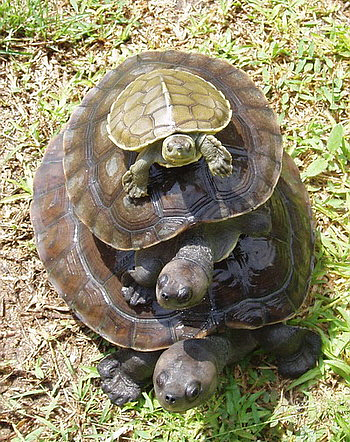
Abb.:
Batagur baska - Batagurschildkröte
"from top to bottom: hatchling of about a week old, one year old and two
years old"
[Bildquelle: MiPe
/ Wikipedia. -- Public domain]
Gattung Geoclemys
dt. Strahlen-Dreikielschildkröte
engl. Black Pond turtle, Spotted Pond turtle
Wikipedia: http://en.wikipedia.org/wiki/Geoclemys_hamiltonii. -- Zugriff am 2007-09-04
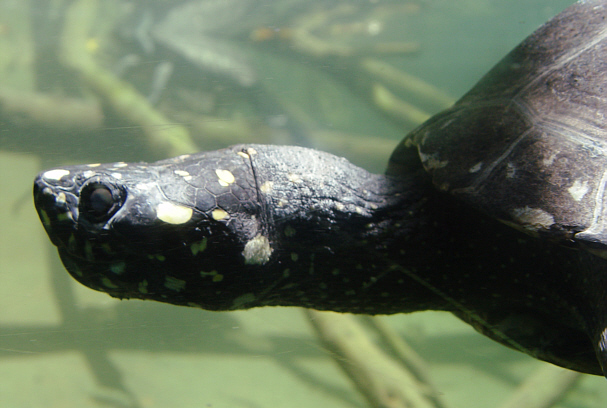
Abb.:
Geoclemys hamiltonii - Strahlen-Dreikielschildkröte
[Bildquelle: Howard Cheng / Wikipedia. -- GNU
FDLicense]
Gattung Hardella
dt. Diadem-Schildkröte
engl. Brahminy River Turtle, Crowned River Turtle
Wikipedia:
http://en.wikipedia.org/wiki/Hardella_thurjii.
-- Zugriff am 2007-09-04
Gattung Kachuga -
Dachschildkröten
dt. Indische Dachschildkröte
engl. Indian Roofed Turtle
Wikipedia:
http://en.wikipedia.org/wiki/Kachuga_tecta.
-- Zugriff am 2007-09-04
Gattung Morenia -
Pfauenaugen-Schildkröten
Indian Eyed Turtle
Wikipedia:
http://en.wikipedia.org/wiki/Morenia_petersi.
-- Zugriff am 2007-09-04
Gattung Aspideretes -
Indische Weichschildkröten
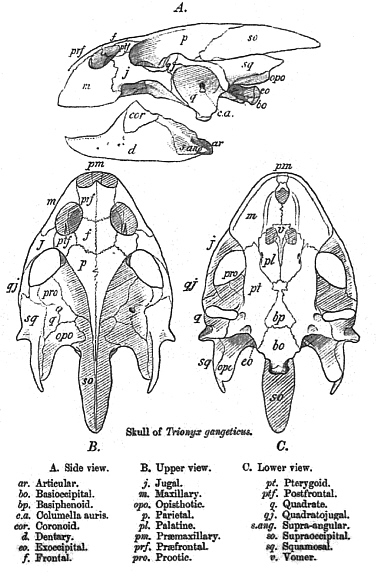
Abb.: Schädel von
Aspideretes gangeticus - Ganges-Weichschildkröte
[Bildquelle:
Boulenger,GA 1890
/ Wikipedia. -- Public domain]
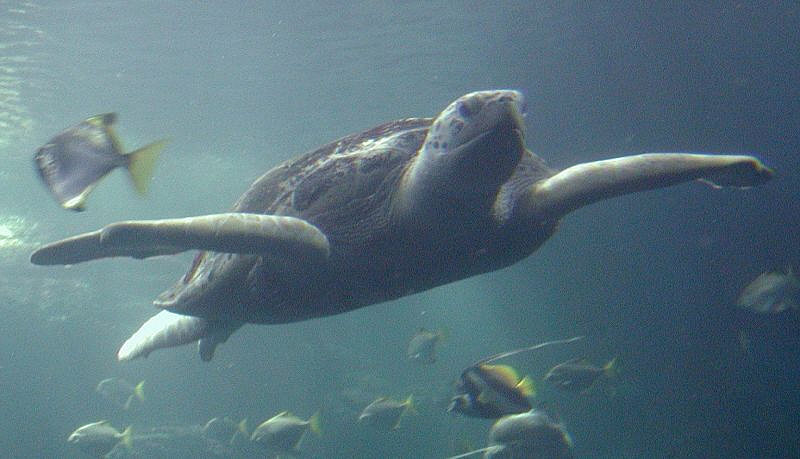
Abb.:
Chelonia mydas - Suppenschildkröte
[Bildquelle: Wilfried
Wittkowsky
/ Wikipedia. -- GNU FDLicense]
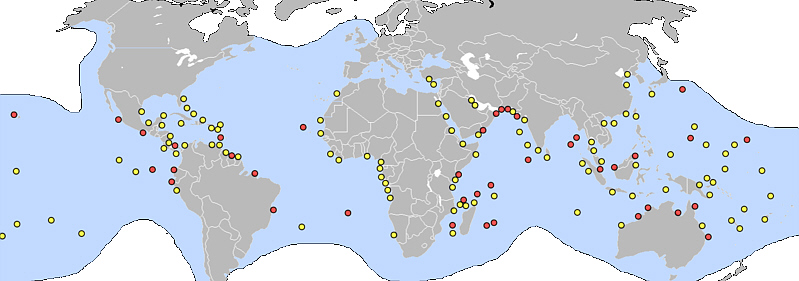
Abb.: Verbreitungsgebiet von
Chelonia mydas - Suppenschildkröte: Yellow circles represent
minor nesting locations. Red circles are known major nesting sites.
[Bildquelle: Pinpin / Wikipedia. -- GNU FDlicense]
Gattung Caretta Rafinesque, 1814
dt. Unechte Karettschildkröte
engl. Loggerhead Sea Turtle
Wikipedia: http://de.wikipedia.org/wiki/Unechte_Karettschildkr%C3%B6te. -- Zugriff am 2007-09-04
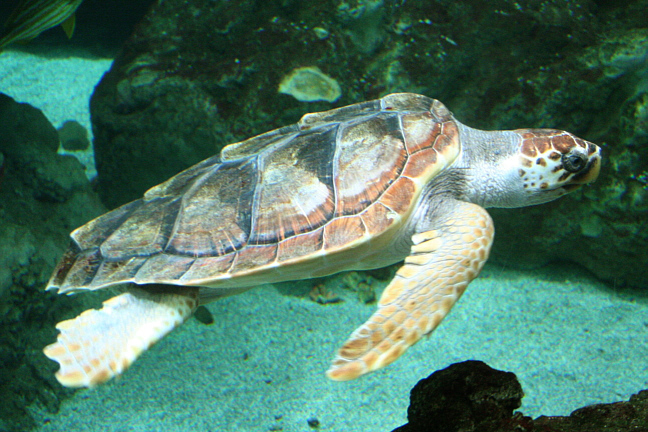
Abb.:
Caretta caretta - Unechte Karettschildkröte
[Bildquelle:
Strobilomyces
/ Wikipedia. -- GNU FDLicense]
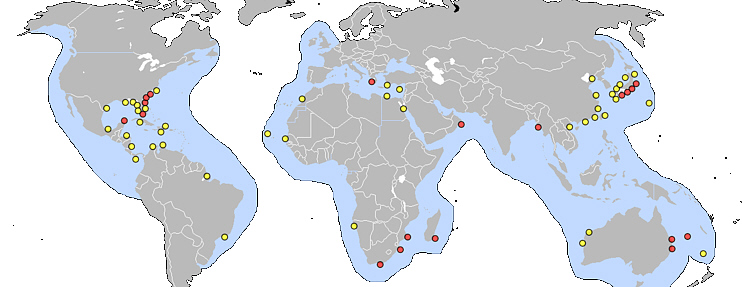
Abb.: Verbreitungsgebiet von
Caretta caretta - Unechte Karettschildkröte:
Yellow circles represent minor nesting locations. Red circles are
known major nesting sites.
[Bildquelle: Wikipedia]
Cunningham:
"Water-tortoises, Trionyx, abound in the Hugli and the countless channels and swamps communicating with it, and specimens are also to be found in many seemingly isolated garden-ponds. Their appearance is far from inviting, owing to their dingy colouring, extremely flattened form, and to the presence of a layer of slime that usually coats their surfaces, and which is often rendered additionally repulsive by being thickly beset with hosts of flukes, that form flickering fringes projecting from it and waving to and fro in the surrounding water. Quite irrespective of their ugliness, they are very uncanny inmates of bathing-ponds, as they are highly carnivorous, and can give very unpleasant bites with their strong, chisel-edged mandibles. It is a curious sight when the still surface of a pond is gently parted as a tortoise rises to protrude his grey snakelike head and neck, and gaze around with dull little eyes, ready on the slightest alarm to slip down again into the depths, oaring his way by vigorous strokes of his stout short legs. Their curious rounded eggs are often to be found lying in heaps among the grass at the edge of the water.
Their shells are so thick and hard that it seems strange that the young ones should ever manage to force their way out, but they can do so with great rapidity under the influence of a sufficient stimulus. I once put a clutch of eggs into a bottle of strong spirit, and within the course of a few minutes, all the shells had been broken by the struggles of the young animals within them."
[Quelle: Cunningham, D. D. (David Douglas) <1843-1914>: Some Indian friends and acquaintances; a study of the ways of birds and other animals frequenting Indian streets and gardens. -- London : J. Murray, 1903. -- viii, 423 S. : Ill. ; 21 cm. -- S. 329f. -- Online: http://www.archive.org/details/someindianfriend00cunnrich. -- Zugriff am 2007-09-15]
Lydekker:
The fourth group comprises about ten very beautifully coloured small, or medium-sized, tortoises, the great majority of which are fined to South Africa, although the species here figured (Testudo elegans) is an inhabitant of India and Ceylon. All these species are easily recognised by the carapace being extremely convex, and either black in colour, with yellow lines radiating from the centre of each of the shields of the back, or yellow, or brownish, marked with radiating black lines. Frequently, moreover, the shields of the back are swollen, so as to form more or less prominent bosses.
The Indian species, together with an allied one (Testudo platynota), from Burma, is distinguished from all the other members of the group by the absence of the nuchal shield at the front ofthe carapace. Of the other eight species no less than seven are South African, while the radiated tortoise (Testudo radiata) is from Madagascar ; one of the best knowm members of the group being the common geometric tortoise (Testudo geometrica) of the Cape, which attains a length of some 5 inches. In the eyed tortoise (Testudo oculifcra) the pectoral shields of the plastron may not meet in the middle line, as is the case in some individuals of the Burmese brown tortoise. While the elegant and geometric tortoise have the carapace black, with narrow yellow rays, in the eyed tortoise the markings take the form of brownish yellow and dark-brown, rays of nearly equal width.
An
admirable account of the habits of the elegant tortoise is given by Capt. T. Hutton, from which the following extracts are made. These tortoises are fairly common in dry, hilly districts, where they inhabit the high grass-jungles at the foot of the hills. Nevertheless, they are by no means easy to find, owing to their colour and appearance harmonising so closely with the rocky ground, and from their habit of remaining in concealment beneath shrubs or tufts of grass during the heat of the day. They are tracked by the Bhils of Meywar to their hiding-places by following the trail of their footsteps in the dry sand ; the same method being employed by some of the wild tribes of South Africa in the case of the allied species inhabiting that continent. In the rainy season the elegant tortoise is, however, extremely active, and wanders about in search of food at all hours of the day. At the approach of the cold weather these reptiles select a sheltered spot, where they conceal themselves by thrusting their shells into thick tufts of bushes or shrubs, in order to be better protected from the cold. There they remain in a kind of lethargic, although not truly torpid, state, till the hot season, when they issue out to feed only after sunset and in the early morning.Specimens kept in captivity were observed to be very fond of plunging into water during the hot season, where they would remain for half an hour at a time. They also drank large qualities of water at this period of the year, which they took
by thrusting in their heads and swallowing in a series of gulps. About November the female lays her eggs in a shallow pit excavated by herself. One of the aforesaid captive specimens in the course of about two hours "succeeded in making a hole six inches in depth and four inches in diameter; in this she immediately deposited her eggs, four in number, filling up the hole again with the mud she had previously scraped out, and then treading it well in, and stamping upon it with her hind-feet alternately until it was filled to the surface, when she bent it down with the whole weight of her body, raising herself behind as high as she could stretch her leg's, and suddenly withdrawing them, allowing herself to drop heavily on the earth, by which means it was speedily beaten flat ; and so smooth and natural did it appear that, had I not detected her in the performance of her task, I should certainly never have noticed the spot where she had deposited her eggs. She did not immediately leave the place after finishing her work, but remained inactive, as if recovering from her fatigues." In disposition these tortoises are decidedly pugnacious, this being especially the case with the males. These combats seemed to be chiefly trials of strength, "one male confronting the other, with the hind and fore-legs drawn into the shell, and the hind-feet planted firmly on the ground, and in this manner striving against each other until one or both became fatigued. This was done chiefly when they wanted to pass each other in any narrow space ; and sometimes if the one could succeed in placing his shell a little beneath the other, he tilted him over on his back, from which he had great difficulty in recovering himself; and I have frequently found them sprawling thus, making desperate efforts with head and feet to throw themselves back to their natural position, which they were unable to' effect unless the ground chanced to be very uneven, so as to assist them.""[Quelle: Lydekker, Richard <1849-1915>: The royal natural history / edited by Richard Lydekker ; with preface by P.L. Sclate. -- London ; New York : F. Warne, 1893-96. -- 6 Bde. : ill. (some col.) ; 26 cm. -- Bd. 5. -- S. 51ff. -- Online: http://www.archive.org/details/royalnaturalhist05lyderich. -- Zugriff am 2007-09-27]
"The
remaining members of the family, which are arranged under four genera, and may be collectively known as batagurs, are exclusively confined to India, Burma, and the Malayan region. They comprise the largest fresh-water representatives of the family, and are readily characterised by the great development of the vertical bony buttresses connecting the carapace with the plastron, which project as walls within the shell, so as partially to divide it into compartments.
Of the four genera, Cachuga, which is represented by seven species from India and Burma, is readily recognised by the great elongation of fourth vertebral horny shield of the carapace, which extends over four or five of the underlying neural bones. The smaller members, such as Smith's batagur (Cachuga smithi), and the black-and-yellow batagur (Cachuga tectum), of the Ganges and Indus, are characterised by the fourth vertebral shield terminating in front in a narrow point. Whereas the former of these lias a depressed and feebly keeled shell, the latter, especially when young, has the carapace much vaulted, and the third vertebral shield produced behind into a conical elevation forming the highest part of the shell. The name of black-and-yellow batagur is derived from the irregular black patches on the bright yellow plastron; the carapace being brown. I have taken specimens of this pretty little batagur, which does not exceed 8 inches in length and is generally much smaller, near the fort at Calcutta. Like the under-mentioned dhongoka, it occurs fossil in the Pliocene deposits of Northern India. The larger species of the genus, such as the Indian dhongoka (Cachuga dhongoka), which grows to over 14 inches, has the fourth vertebral shield broad in front, instead of being narrowed to a point. The three remaining genera, Callagur, Batagur, and Hardella, differ from the preceding in that the fourth vertebral shield of the carapace is not longer than the third ; but it will be unnecessary to point out the features by which they are severally distinguished. The largest of all is the true batagur (Batagur lasca), in which the carapace measures upwards of 20 inches in length.
All the batagurs are exclusively vegetable feeders, and the larger species are thoroughly aquatic in their habits, spending by far the greater portion of their time in the water. They abound in the larger rivers of India and Burma, where their huge shells form conspicuous objects as they rise to the surface to breathe.
Describing the habits of a captive specimen, Dr. John Anderson states that when it rose to breathe "its nostrils were simply protruded above the surface of the water, and retained in that position for about half a minute, during which it made a long expiration, followed by a deep inspiration, the creature then slowly subsiding, tail-backwards, to the bottom. The animals, unless they were much irritated, never attempted to bite, but, when so treated, they sluggishly seized any object put in their way, holding it between their jaws with considerable tenacity, at the same time withdrawing the head into the shell. They moved about on the ground with considerable agility, supporting their heavy bodies erect on their legs, like a land-tortoise." Another species will occasionally snap, when, owing to the friction of its serrated jaws against each other, a peculiar kind of barking sound is produced. Batagurs are eaten in Lower Bengal by some of the inferior castes of Hindus, and are kept for this purpose in tanks."
[Quelle: Lydekker, Richard <1849-1915>: The royal natural history / edited by Richard Lydekker ; with preface by P.L. Sclate. -- London ; New York : F. Warne, 1893-96. -- 6 Bde. : ill. (some col.) ; 26 cm. -- Bd. 5. -- S. 74f. -- Online: http://www.archive.org/details/royalnaturalhist05lyderich. -- Zugriff am 2007-09-27]
Widely celebrated as being the source of the far-famed turtlesoup of civic banquets, the green turtle (Chelone mydas) is one of two species belonging to a genus characterised
by the presence of four pairs of costal shields on the carapace, and by the persistence of the vacuities between the costal and marginal bones of the latter throughout life. The plastron is, moreover, distinoguished by the presence of an intergular shield between the two gulars ; while, as in the second genus, there is a row of inframarginal shields between the marginals and the proper shields of the plastron. The skull is of moderate size in comparison to the shell, with the sockets of the eyes placed nearly vertically, and separated by a broad bar of bone. Such are the characters common to the two species of the typical genus of the family.
The green turtle is specially distinguished
by its short beak, which is devoid of a hook at the tip, and by the shields of the carapace being in contact by their edges all through life. In the young, the carapace shows a faint median keel ; while its hinder margin is at most but feebly serrated at all ages. Generally there is but a single claw on each paddle, although, in some instances, young specimens also have a claw on the second digit. In colour, the shell of the adult is olive or brown, with yellowish spots or marblings; while in the young it is uniform dark brown or olive above, and yellow beneath, the limbs being bordered with yellow on the upper surface, and inferiorly yellow with a brown spot near the extremity. The food of the species consists of seaweeds, especially the seawrack, upon which the turtles graze at the bottom of the water, rising occasionally to the surface to breathe. "[Quelle: Lydekker, Richard <1849-1915>: The royal natural history / edited by Richard Lydekker ; with preface by P.L. Sclate. -- London ; New York : F. Warne, 1893-96. -- 6 Bde. : ill. (some col.) ; 26 cm. -- Bd. 5. -- S. 82f. -- Online: http://www.archive.org/details/royalnaturalhist05lyderich. -- Zugriff am 2007-09-27]